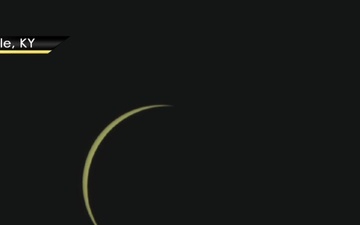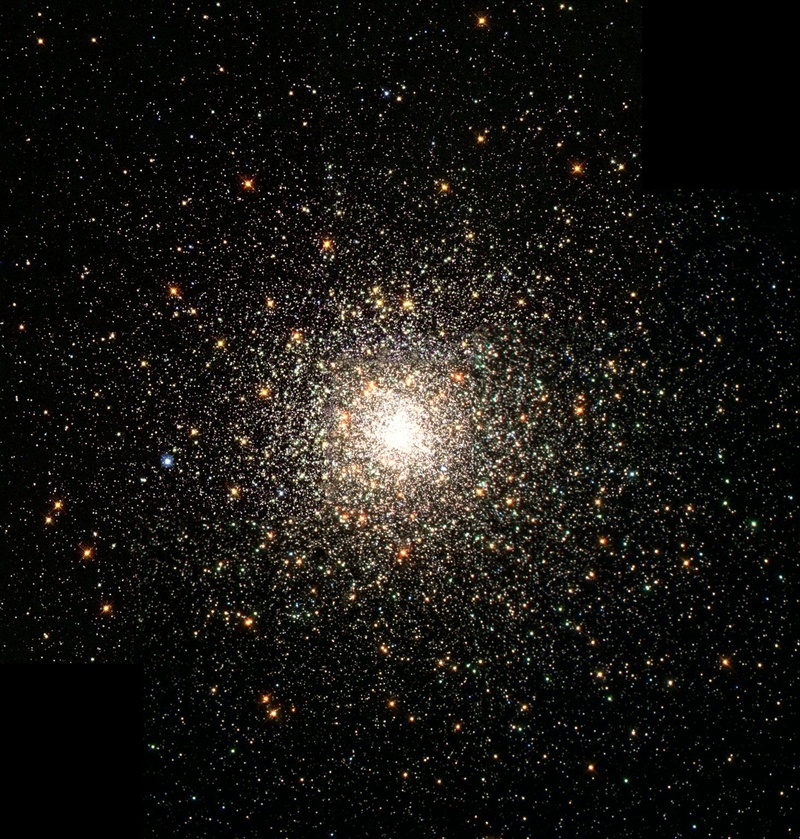This stellar swarm is M80 (NGC 6093), one of the densest of the 147 known globular star clusters in the Milky Way galaxy. Located about 28,000 light-years from Earth, M80 contains hundreds of thousands of stars, all held together by their mutual gravitational attraction. Globular clusters are particularly useful for studying stellar evolution, since all of the stars in the cluster have the same age (about 15 billion years), but cover a range of stellar masses. Every star visible in this image is either more highly evolved than, or in a few rare cases more massive than, our own Sun. Especially obvious are the bright red giants, which are stars similar to the Sun in mass that are nearing the ends of their lives. By analyzing the Wide Field and Planetary Camera 2 (WFPC2) images, including images taken through an ultraviolet filter, astronomers have found a large population of "blue stragglers" in the core of the cluster. These stars appear to be unusually young and more massive than the other stars in a globular cluster. However, stellar collisions can occur in dense stellar regions like the core of M80 and, in some cases, the collisions can result in the merger of two stars. This produces an unusually massive single star, which mimics a normal, young star. M80 was previously unknown to contain blue stragglers, but is now known to contain more than twice as many as any other globular cluster surveyed with NASA's Hubble Space Telescope (HST). Based on the number of blue stragglers, the stellar collision rate in the core of M80 appears to be exceptionally high. M80 is also unusual because it was the site of a nova explosion in the year 1860. Nova outbursts occur when a close companion star transfers fresh hydrogen fuel to a burned-out white dwarf. Eventually the hydrogen ignites a thermonuclear explosion on the surface of the white dwarf, giving rise to the nova outburst. The ultraviolet Hubble observations have revealed the hot, faint remnant of this exploding star, which was named T Scorpii in the 19th century. Curiously, however, the WFPC2 observations have revealed only two other nova-like close binary stars in M80, far fewer than expected theoretically based on the stellar collision rate. So the blue stragglers in M80 seem to indicate that there are lots of collisions, yet the nova-like stars suggest only a few. Sometimes life for astronomers isn't so simple, but it is from exploring discrepancies like this that our understanding eventually deepens. This high-resolution image was created from 2 separate pointings of HST. One WFPC2 data set was obtained by Francesco R. Ferraro (ESO, Bologna Obs.), Barbara Paltrinieri (U. La Sapienza), Robert T. Rood (U. Virginia), and Ben Dorman (Raytheon/STX), who study blue stragglers. The other data set was acquired by Michael Shara (STScI, AMNH), David Zurek (STScI), and Laurent Drissen (U. Laval) to search for dwarf novae. Technical facts about this news release: About this Object Object Name: NGC 6093 (M80) Object Description: Globular Cluster in the Milky Way Galaxy Position (J2000): R.A. 16h 17m 03s Dec. -22° 58' 30" Constellation: Scorpius Distance: 8.7 kiloparsecs (28,000 light-years) Dimensions: The image is 3 arcminutes on the vertical side. About the Data Instrument: WFPC2 Exposure Dates: October 1994, August-October, 1997; January/April, 1996 Filters: F336W(U), F439(B), F555W(V), F675W(R) Principal Astronomers: 1994/1997 Image: M. Shara (STScI, AMNH), D. Zurek (STScI), L. Drissen (Laval University). 1996 Image: F. Ferraro (ESO), B. Paltrinieri (Universita La Sapienza), R. Rood (University of Virginia), B. Dorman (Raytheon STX & Laboratory for Astronomy & Solar Physics). _________________________________________ About this Image Image Credit: NASA and The Hubble Heritage Team (STScI/AURA) Release Date: July 1, 1999 12:00 noon (EDT) Orientation: North is toward the upper right of the image. What is Hubble Heritage? A monthly showcase of new and archival Hubble images. Go to the Heritage site. This stellar swarm is M80 (NGC 6093), one of the densest of the 147 known globular star clusters in the Milky Way Galaxy. Located about 28,000 light-years from Earth, M80 contains hundreds of thousands of stars, all held together by their mutual gravitational attraction. Globular clusters are particularly useful for studying stellar evolution, since all of the stars in the cluster have the same age (about 15 billion years), but cover a range of stellar masses. Every star visible in this image is either more highly evolved than, or in a few rare cases more massive than, our own Sun. Especially obvious are the bright red giants, which are stars similar to the Sun in mass that are nearing the ends of their lives. *News Release Number:*: STScI-1999-26a
NASA Identifier: SPD-HUBBLE-STScI-1999-26a
Taken: 09.22.2009 | Courtesy Photo


















